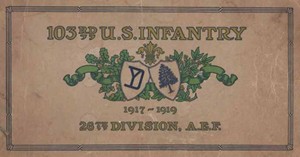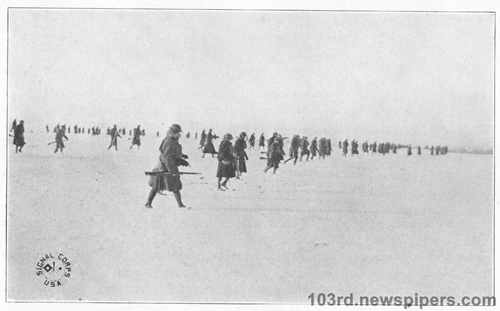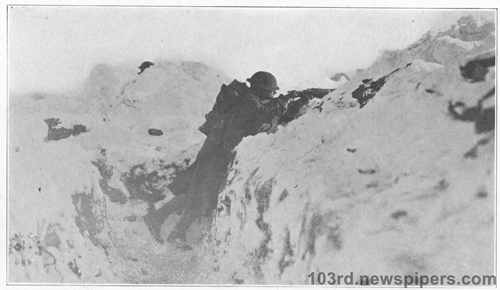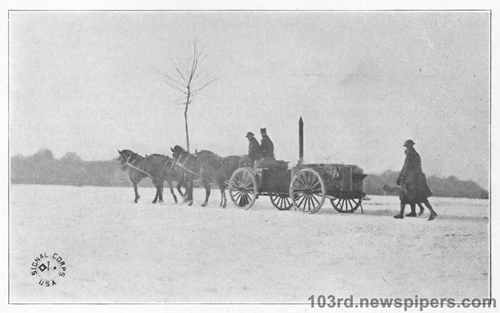
of the 26th Division of the U.S. Army
during World War I
 | The History of the 103rd Regiment of the 26th Division of the U.S. Army during World War I |
| Table of Contents | ||
 with its auxiliary units, machine guns, one~pounders, and slokes would hold,—- a
front line 0f ohservation, Tr. de Boston; line of resistance, Tr. de Newport; and
support line, Tr. de New Haven.
VVOrk on the trenches did not progress rapidly but was Finally finished, and the
next step was instruction in the making of reliefs and disposition of troops in the
trenches. This was practiced both during daytime and at night, the battalions
of the regiment relieving one another. Sonic of the dificulties encountered under
actual conditions were experieneed,—bad weather, intense darkness, and the neces-
sity for silence, and in practice, of course, some nien figuratively and actually
trot lost, for though the Noncourt subsection looks simple on a stretch, it was a
different proposition at midnight in a driving storm, Signal rockets, buzzors,
and runners were used, and everything was done to inake conditions as nearly
real as possible.
By the first of Janimry the rcgiinent had heen well grounded in the funda—
nientals, not the least of which was getting the men to knew how to take care of
their health under all sorts of conditions, for drill was carried on whatever the
weather, cold, rain, or snow; and the men became hard and fit. The last of the
period was devoted to target and rifle work, a good deal of which was crowded
into the last two weeks of the stay at Lilfol.
Along with other work battalion and regimentul inanueuvres were conducted.
The regiment had its share of detail also, for each company in turn went to Neuf-
ehfiteau to work at the niilhearl tluere and at Rebevul liarrarks, principally load-
ing and unloading of cars. This was a necessity due to the fact that at that time
Labor Battalions had not arrived or been organized in sufi·i~i-nt number to ineet
conditions. _
Beginning with about the last of November pursuant to plans of General Head-
quarters a certain number of ofH·1~rs and noneemmissirmed officers was sent to
Gcndrccourt to the " First Corps S·hol." The cmirse taken there was il n10nth’s
intensive training in all of the dii't`ei·ent branches oi infantry work, certain officers
being assigned to special eou1·ses,—musketry, tactics, etc. These officers then
returned (unless held as instructors) to the organization and were of ·o11rs· able
to give valuable instructions to the other officers and men.
The school at Gondrecourt, one of the first to be organized for the instruction
of American nHizers and men, was the forerunner of that group of schools which
was developed before the end of the war throughout the A. E. F. School life was
not any vacation; the program was as full and hard as that of the training camps
in the states. The American officers in charge were assisted by English and
French officers attached to the American forces for that purpose. Officers show-
ing proficiency and excellency with the ability to instruct were retained at the
with its auxiliary units, machine guns, one~pounders, and slokes would hold,—- a
front line 0f ohservation, Tr. de Boston; line of resistance, Tr. de Newport; and
support line, Tr. de New Haven.
VVOrk on the trenches did not progress rapidly but was Finally finished, and the
next step was instruction in the making of reliefs and disposition of troops in the
trenches. This was practiced both during daytime and at night, the battalions
of the regiment relieving one another. Sonic of the dificulties encountered under
actual conditions were experieneed,—bad weather, intense darkness, and the neces-
sity for silence, and in practice, of course, some nien figuratively and actually
trot lost, for though the Noncourt subsection looks simple on a stretch, it was a
different proposition at midnight in a driving storm, Signal rockets, buzzors,
and runners were used, and everything was done to inake conditions as nearly
real as possible.
By the first of Janimry the rcgiinent had heen well grounded in the funda—
nientals, not the least of which was getting the men to knew how to take care of
their health under all sorts of conditions, for drill was carried on whatever the
weather, cold, rain, or snow; and the men became hard and fit. The last of the
period was devoted to target and rifle work, a good deal of which was crowded
into the last two weeks of the stay at Lilfol.
Along with other work battalion and regimentul inanueuvres were conducted.
The regiment had its share of detail also, for each company in turn went to Neuf-
ehfiteau to work at the niilhearl tluere and at Rebevul liarrarks, principally load-
ing and unloading of cars. This was a necessity due to the fact that at that time
Labor Battalions had not arrived or been organized in sufi·i~i-nt number to ineet
conditions. _
Beginning with about the last of November pursuant to plans of General Head-
quarters a certain number of ofH·1~rs and noneemmissirmed officers was sent to
Gcndrccourt to the " First Corps S·hol." The cmirse taken there was il n10nth’s
intensive training in all of the dii't`ei·ent branches oi infantry work, certain officers
being assigned to special eou1·ses,—musketry, tactics, etc. These officers then
returned (unless held as instructors) to the organization and were of ·o11rs· able
to give valuable instructions to the other officers and men.
The school at Gondrecourt, one of the first to be organized for the instruction
of American nHizers and men, was the forerunner of that group of schools which
was developed before the end of the war throughout the A. E. F. School life was
not any vacation; the program was as full and hard as that of the training camps
in the states. The American officers in charge were assisted by English and
French officers attached to the American forces for that purpose. Officers show-
ing proficiency and excellency with the ability to instruct were retained at the
 Along with other work battalion and regimental manueuvres were conducted.
The regiinent had its share of detail also, for each company in turn went to Neuf—
chateau to work at the railhead tliere and at Rebeval l§ar1·at·ks, principally load-
ing and unloading of cars. This was a necessity due to the fact that at that time
Labor Battalions had not arrived or been organized in sufl·i·i-nt number to meet
conditions.
Beginning with about the last of November pursuant to plans of General Head-
quarters a certain number ol` oftic1~rs and noncominissinned officers was sent to
Gondrcconrt to the " First Corps S·hool." The course taken there was il m0nth’s
intensive training in all of the diilerent branches of infantry work, certain officers
being assigned to special cou1·scs,—musketry, tactics, etc. These officers then
returned (unless held as instructors) to the organization and were of ·o11rs· able
to give valuable instructions to the other officers and men.
The school at Gondrecourt, one of the First to be organized for the instruction
of American nfheers and men, was the forerunner of that group of schools which
was developed before the end of the war throughout the A. E. F. School life was
not any vacation; the program was as full and hard as that of the training camps
in the states. The American officers in charge were assisted by English and
French officers attached to the American forces for that purpose. Oflicers show-
ing proficiency and excellency with the ability to instruct were retained at the
school or detached and sent to other schools and divisions. The1·e seemed to be
a concerted eilort all along the line to raise the standard of training as high as
possible. This system of Corps, and later Army, schools was one of the means.
It has already been said that the regiment had by the first of January received
a good foundation training. Of course the next question was, “‘When will the
Division go in?" The regiment was made ready several weeks prior to the date
of actual departure and only awaited thc orders to pro. The move finally came
the first week in February, the regiment leaving February 5 and 6. Prior
to its departure the entire regiinent with full equipinent, trains and all, was re-
viewed (February 2) by the Brigade Commander. That, too, was a day not to
be forgotten; the 103rd was ready. The next step on the great adventure lay
ahead. One cannot easily forget it for, of the ofheers who passed by that day,
about twenty-five per cent are left; of the men, not fifty per cent. It was at fine-
lookin;15 lot of men; it was sueh at spectacle as is not olten given to men to be a
part of. Out there on that rolling lield in platoon front they marched in review,
"eyes right," as they passed (lennral Cole who stood alone, carried the challenge
"we are ready," and they were ready. And who was there to cheer the regiment.
on its way? None but the simple villagers who knew what it meant; for four
years they had been seeing their own march away.
Along with other work battalion and regimental manueuvres were conducted.
The regiinent had its share of detail also, for each company in turn went to Neuf—
chateau to work at the railhead tliere and at Rebeval l§ar1·at·ks, principally load-
ing and unloading of cars. This was a necessity due to the fact that at that time
Labor Battalions had not arrived or been organized in sufl·i·i-nt number to meet
conditions.
Beginning with about the last of November pursuant to plans of General Head-
quarters a certain number ol` oftic1~rs and noncominissinned officers was sent to
Gondrcconrt to the " First Corps S·hool." The course taken there was il m0nth’s
intensive training in all of the diilerent branches of infantry work, certain officers
being assigned to special cou1·scs,—musketry, tactics, etc. These officers then
returned (unless held as instructors) to the organization and were of ·o11rs· able
to give valuable instructions to the other officers and men.
The school at Gondrecourt, one of the First to be organized for the instruction
of American nfheers and men, was the forerunner of that group of schools which
was developed before the end of the war throughout the A. E. F. School life was
not any vacation; the program was as full and hard as that of the training camps
in the states. The American officers in charge were assisted by English and
French officers attached to the American forces for that purpose. Oflicers show-
ing proficiency and excellency with the ability to instruct were retained at the
school or detached and sent to other schools and divisions. The1·e seemed to be
a concerted eilort all along the line to raise the standard of training as high as
possible. This system of Corps, and later Army, schools was one of the means.
It has already been said that the regiment had by the first of January received
a good foundation training. Of course the next question was, “‘When will the
Division go in?" The regiment was made ready several weeks prior to the date
of actual departure and only awaited thc orders to pro. The move finally came
the first week in February, the regiment leaving February 5 and 6. Prior
to its departure the entire regiinent with full equipinent, trains and all, was re-
viewed (February 2) by the Brigade Commander. That, too, was a day not to
be forgotten; the 103rd was ready. The next step on the great adventure lay
ahead. One cannot easily forget it for, of the ofheers who passed by that day,
about twenty-five per cent are left; of the men, not fifty per cent. It was at fine-
lookin;15 lot of men; it was sueh at spectacle as is not olten given to men to be a
part of. Out there on that rolling lield in platoon front they marched in review,
"eyes right," as they passed (lennral Cole who stood alone, carried the challenge
"we are ready," and they were ready. And who was there to cheer the regiment.
on its way? None but the simple villagers who knew what it meant; for four
years they had been seeing their own march away.

|
||
| Original Version of Page |